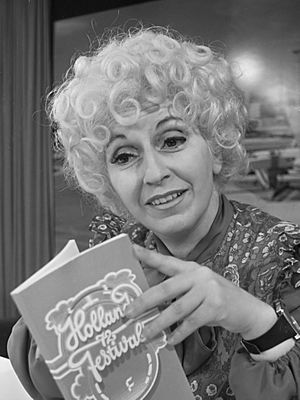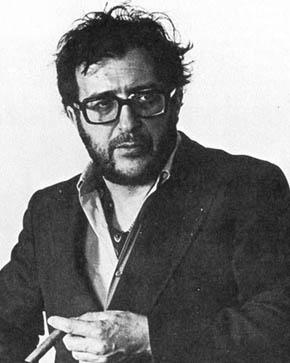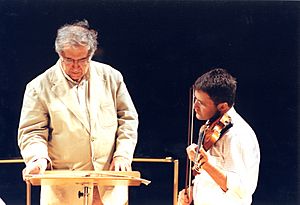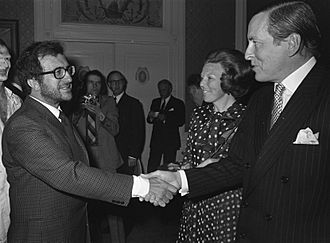Luciano Berio facts for kids
Luciano Berio (born October 24, 1925 – died May 27, 2003) was a famous Italian composer. He was known for his experimental music, especially his piece Sinfonia from 1968 and his amazing solo pieces called Sequenza. He also did important work in electronic music. Early in his career, he was inspired by Igor Stravinsky and tried out new techniques like serial music and electronic sounds. Later, he explored music where some parts were left to chance, and he used spoken words as a main part of his compositions.
Contents
About Luciano Berio
Berio was born in a town called Oneglia, which is now part of Imperia, on the coast of Italy. His father and grandfather were both organ players, and they taught him how to play the piano. During World War II, he had to join the army. On his very first day, he accidentally hurt his hand while learning about a gun. He then spent some time in a military hospital.

After the war, Berio studied music at the Milan Conservatory. Because of his injured hand, he couldn't play the piano as much, so he focused on composing music instead. In 1947, one of his piano pieces was performed in public for the first time. To earn money, Berio played piano for singing classes. That's how he met Cathy Berberian, an American singer. They got married soon after he graduated, but later divorced in 1964. They had a daughter named Cristina. Berio wrote many pieces that showed off Cathy Berberian's special voice.
In 1952, Berio traveled to the United States to study with another composer, Luigi Dallapiccola. From him, Berio became interested in a style of music called serialism. He also went to a summer music school in Germany where he met other important composers like Pierre Boulez and John Cage. He became very interested in electronic music. In 1955, he helped start an electronic music studio in Milan called the Studio di fonologia musicale. He invited many famous composers to work there. He also published a magazine about electronic music.
Teaching and Composing
In 1960, Berio returned to the US as a special composer at Tanglewood. In 1962, he started teaching at Mills College in California. From 1960 to 1962, he also taught at a summer school in England. In 1965, he began teaching at the Juilliard School in New York. There, he created a group called the Juilliard Ensemble, which played contemporary music (music from our time). In 1966, he married Susan Oyama, a philosopher, but they divorced in 1972. Some of his students became famous musicians, including Steve Reich.
During these years, Berio kept composing and becoming more well-known. In 1966, he won the Prix Italia for his work Laborintus II. This piece used voices, instruments, and tape recordings. His fame grew even more when his piece Sinfonia was first performed in 1968. In 1972, Berio moved back to Italy. From 1974 to 1980, he led the electronic music division at a famous music research center in Paris called IRCAM. In 1977, he married musicologist Talia Pecker.
In 1987, he opened Tempo Reale, a center for music research in Florence, Italy. He received many awards and honors, including becoming an Honorary Member of the Royal Academy of Music in London in 1988. In 1994, he became a special composer at Harvard University in the US, staying there until 2000. He also gave lectures at Harvard, which were later published as a book. In 2000, he became the head of the Accademia Nazionale di Santa Cecilia in Rome.
Berio also conducted orchestras and composed music until the end of his life. He passed away in 2003 in Rome. He was known for his great sense of humor. Once, he gave a two-hour talk about how amazing Beethoven's 7th Symphony was. The next day, with a serious face, he gave another two-hour talk explaining why the same symphony was actually terrible.
Luciano Berio's Music
Most of Berio's electronic music was created when he worked at the Studio di Fonologia in Milan. One of his most important electronic pieces was Thema (Omaggio a Joyce) (1958). It used a recording of Cathy Berberian reading from James Joyce's book Ulysses. This piece is considered one of the first electroacoustic works in Western music that used a voice and changed it with technology. Another piece, Visage (1961), shows Berio creating a wordless emotional language. He did this by cutting and rearranging recordings of Cathy Berberian's voice. The music uses the sounds of gestures and voice changes, from simple sounds to laughter, tears, and singing.
In 1968, Berio finished O King. This piece has two versions: one for a singer and a few instruments, and another for eight voices and an orchestra. He wrote it to remember Martin Luther King Jr., who had been killed shortly before. In the piece, the voices first sing the vowels, then the consonants of King's name. They only put the full name together in the very last part of the music.
The orchestral version of O King was soon added to what is probably Berio's most famous work, Sinfonia (1967–69). This piece is for an orchestra and eight amplified voices. The voices don't always sing in a traditional way. They often speak, whisper, or even shout. The third part of Sinfonia is like a collage of quotes from books and other music. A-Ronne (1974) is also like a collage, but it focuses more on the voice. It was first a radio show for five actors, then changed for eight singers. This piece was one of many collaborations with the poet Edoardo Sanguineti. He provided a text full of quotes from places like the Bible and Karl Marx.
Another example of Sanguineti's influence is the large work Coro (first performed in 1977). It's for orchestra, solo singers, and a big choir. Each choir member is paired with an instrument from the orchestra. The piece lasts about an hour and explores different themes using folk music from various parts of the world, like Chile, North America, and Africa. Common themes include love, the pain of being separated from loved ones, and the death of a partner. A line often repeated is "come and see the blood on the streets," which refers to a poem about the civil war in Spain.
In his later years, Berio also used "live electronics" in his music. This means electronic sounds were created or changed during a live performance. Examples include Ofanìm (1988–1997) and Altra voce (1999). The electronic parts of these pieces were always performed by musicians from his Tempo Reale center.
The Sacher Project
A famous cellist named Mstislav Rostropovich asked twelve composers, including Berio, to write a solo cello piece. This was to celebrate the 70th birthday of a Swiss conductor named Paul Sacher. The composers had to use the letters of Sacher's name (S, A, C, H, E, Re) to create musical notes. These pieces were published together as 12 Hommages à Paul Sacher. Berio's piece was called Les mots sont allés (The Words Are Gone).
The Sequenza Series
Berio created a series of very difficult pieces for solo instruments called Sequenza. The first one, Sequenza I, was for flute in 1958. The last one, Sequenza XIV (2002), was for cello. These pieces explore all the different sounds and techniques an instrument can make, often asking musicians to use special ways of playing.
Here are the different Sequenza pieces:
- Sequenza I for flute (1958)
- Sequenza II for harp (1963)
- Sequenza III for woman's voice (1966)
- Sequenza IV for piano (1966)
- Sequenza V for trombone (1966)
- Sequenza VI for viola (1967)
- Sequenza VII for oboe (1969)
- Sequenza VIIb for soprano saxophone (1993)
- Sequenza VIII for violin (1976)
- Sequenza IXa for clarinet (1980)
- Sequenza IXb for alto saxophone (1981)
- Sequenza IXc for bass clarinet (1998)
- Sequenza X for trumpet and piano (1984)
- Sequenza XI for guitar (1987–88)
- Sequenza XII for bassoon (1995)
- Sequenza XIII for accordion (1995)
- Sequenza XIVa for cello (2002)
- Sequenza XIVb for double bass (2004)
Stage Works
Berio also wrote music for the stage, like operas:
- Opera (1970, revised 1977)
- La vera storia (1982)
- Un re in ascolto (1984)
- Vor, während, nach Zaide (1995; a prelude, interlude, and ending for an unfinished opera by Mozart)
- Outis (1996)
- Cronaca del luogo (1999)
- Turandot (2001; an ending for the opera by Puccini)
Adapting and Arranging Music
Berio was known for taking music by other composers and changing or adapting it. He also adapted his own music. For example, his Sequenze pieces often led to new works called Chemins. Chemins II (1967) took the original Sequenza VI for viola and added nine other instruments. Chemins II was then turned into Chemins III (1968) by adding an orchestra. He also made Chemins IIb and Chemins IIc, which were different versions of Chemins II. Other Sequenze pieces also became new works, like Corale (1981), which was based on Sequenza VIII.
Besides his own works, Berio arranged music by other composers, including Claudio Monteverdi, Johannes Brahms, and Gustav Mahler. For Cathy Berberian, he created Folk Songs (1964), which were arrangements of traditional folk songs. He also wrote an ending for Giacomo Puccini's opera Turandot (first performed in 2002). In his piece Rendering (1989), he took the unfinished sketches for Franz Schubert's Symphony No. 10 and completed them using other music by Schubert.
Berio believed that adapting music was a very important part of composing. He didn't like the term "collage" for his work, preferring "transcription." He felt that "collage" sounded too random, while his adaptations were carefully planned and full of meaning. He said that each musical quote in his work carefully reminded listeners of its original piece, creating a complex but clear network of ideas. He saw his compositions as a way to explore and understand myths, stories, words, and other musical works.
Berio often focused on the voice, piano, flute, and string instruments in his compositions. He wrote many amazing piano pieces, from solos to concerto-like works. He also created unique polyphony (music with multiple independent melodies) in his smaller instrumental pieces. Examples include Différences for flute, harp, clarinet, cello, violin, and electronic sounds, and Chemins IV for eleven strings and oboe.
Awards and Honors
See also
 In Spanish: Luciano Berio para niños
In Spanish: Luciano Berio para niños




